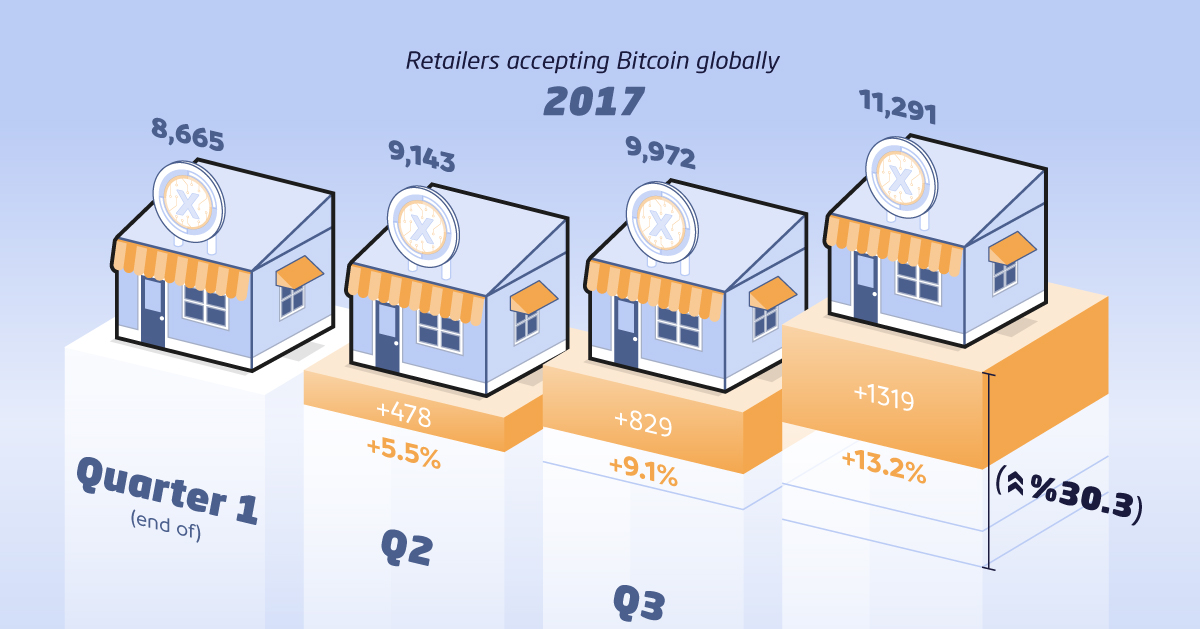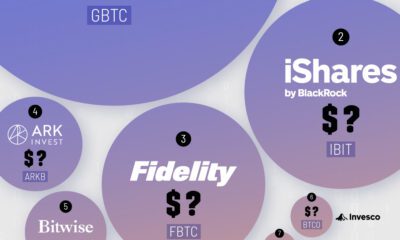Technology
The Future of Crypto Payments in the Retail Market

In the original whitepaper, Satoshi Nakamoto envisioned Bitcoin as a peer-to-peer version of electronic cash that would facilitate transactions without the oversight on a trustworthy, centralized party.
Since then, cryptocurrency has surged in popularity as an asset class – and Bitcoin is now just one of many digital currencies out there. Investment has poured into the sector because many see the blockchain as an important foundational technology for the future, and it’s also gained traction for speculative reasons.
However, strictly from a payments perspective, certain issues have cropped up since the original Bitcoin vision was outlined, and they’ve ultimately prevented crypto from receiving mainstream adoption as a currency for day-to-day transactions.
What are these obstacles, and how will they be overcome?
The Retail Opportunity
Today’s infographic comes to us from NetCents, and it highlights the growing acceptance of cryptocurrency by retailers and a willingness for consumers to consider using it.
Importantly, the graphic also highlights the major hindrances preventing crypto from reaching mass payment adoption, as well as how the future may look significantly different than today.
In 2017, the amount of brick-and-mortar retailers accepting crypto grew by 30.3% to 11,291 retailers globally.
At the same time, users have also warmed up to the idea: a recent survey found that 40% of people familiar with the digital currency would be open to using it in everyday transactions.
So why aren’t most people able to buy a coffee at their neighborhood cafe with Bitcoin?
Payment Challenges
There are three main obstacles to using cryptocurrency for everyday transactions. (Note: this list mainly focuses on Bitcoin examples)
1. Price volatility
In 2017 alone, the Bitcoin price fluctuated between $1,000 and $20,000. Big swings in price make it unattractive for day-to-day transactions.
2. Slow transaction times
The average confirmation for Bitcoin takes about 20 minutes per transaction right now – but during past stretches of activity (such as in Jan 2018), it got as high as 41 hours.
3. High transaction fees
The average transaction costs around $1 right now, but just months ago, the average Bitcoin transaction costed $40.
These factors are not necessarily problematic at all times – but one can see why these challenges may make crypto less appealing for everyday retail transactions, such as one at the grocery store or the local coffee shop.
Crypto to the Masses?
Despite these concerns, there is much optimism that crypto can be a boon to retailers – even brick-and-mortar ones. The blockchain is still new, and people around the world are working to solve these payments issues night and day.
Crypto e-payments companies are constantly introducing new technologies and features that could potentially decrease transaction costs and provide instant settlements for retailers, while also eliminating the issue of fraudulent chargebacks. Making ground on these issues would make crypto significantly more appealing to the masses as a form of payment.
What else needs to be done to push crypto into the mainstream?
Technology
All of the Grants Given by the U.S. CHIPS Act
Intel, TSMC, and more have received billions in subsidies from the U.S. CHIPS Act in 2024.

All of the Grants Given by the U.S. CHIPS Act
This was originally posted on our Voronoi app. Download the app for free on iOS or Android and discover incredible data-driven charts from a variety of trusted sources.
This visualization shows which companies are receiving grants from the U.S. CHIPS Act, as of April 25, 2024. The CHIPS Act is a federal statute signed into law by President Joe Biden that authorizes $280 billion in new funding to boost domestic research and manufacturing of semiconductors.
The grant amounts visualized in this graphic are intended to accelerate the production of semiconductor fabrication plants (fabs) across the United States.
Data and Company Highlights
The figures we used to create this graphic were collected from a variety of public news sources. The Semiconductor Industry Association (SIA) also maintains a tracker for CHIPS Act recipients, though at the time of writing it does not have the latest details for Micron.
| Company | Federal Grant Amount | Anticipated Investment From Company |
|---|---|---|
| 🇺🇸 Intel | $8,500,000,000 | $100,000,000,000 |
| 🇹🇼 TSMC | $6,600,000,000 | $65,000,000,000 |
| 🇰🇷 Samsung | $6,400,000,000 | $45,000,000,000 |
| 🇺🇸 Micron | $6,100,000,000 | $50,000,000,000 |
| 🇺🇸 GlobalFoundries | $1,500,000,000 | $12,000,000,000 |
| 🇺🇸 Microchip | $162,000,000 | N/A |
| 🇬🇧 BAE Systems | $35,000,000 | N/A |
BAE Systems was not included in the graphic due to size limitations
Intel’s Massive Plans
Intel is receiving the largest share of the pie, with $8.5 billion in grants (plus an additional $11 billion in government loans). This grant accounts for 22% of the CHIPS Act’s total subsidies for chip production.
From Intel’s side, the company is expected to invest $100 billion to construct new fabs in Arizona and Ohio, while modernizing and/or expanding existing fabs in Oregon and New Mexico. Intel could also claim another $25 billion in credits through the U.S. Treasury Department’s Investment Tax Credit.
TSMC Expands its U.S. Presence
TSMC, the world’s largest semiconductor foundry company, is receiving a hefty $6.6 billion to construct a new chip plant with three fabs in Arizona. The Taiwanese chipmaker is expected to invest $65 billion into the project.
The plant’s first fab will be up and running in the first half of 2025, leveraging 4 nm (nanometer) technology. According to TrendForce, the other fabs will produce chips on more advanced 3 nm and 2 nm processes.
The Latest Grant Goes to Micron
Micron, the only U.S.-based manufacturer of memory chips, is set to receive $6.1 billion in grants to support its plans of investing $50 billion through 2030. This investment will be used to construct new fabs in Idaho and New York.
-

 Debt1 week ago
Debt1 week agoHow Debt-to-GDP Ratios Have Changed Since 2000
-

 Markets2 weeks ago
Markets2 weeks agoRanked: The World’s Top Flight Routes, by Revenue
-

 Countries2 weeks ago
Countries2 weeks agoPopulation Projections: The World’s 6 Largest Countries in 2075
-

 Markets2 weeks ago
Markets2 weeks agoThe Top 10 States by Real GDP Growth in 2023
-

 Demographics2 weeks ago
Demographics2 weeks agoThe Smallest Gender Wage Gaps in OECD Countries
-

 United States2 weeks ago
United States2 weeks agoWhere U.S. Inflation Hit the Hardest in March 2024
-

 Green2 weeks ago
Green2 weeks agoTop Countries By Forest Growth Since 2001
-

 United States2 weeks ago
United States2 weeks agoRanked: The Largest U.S. Corporations by Number of Employees













